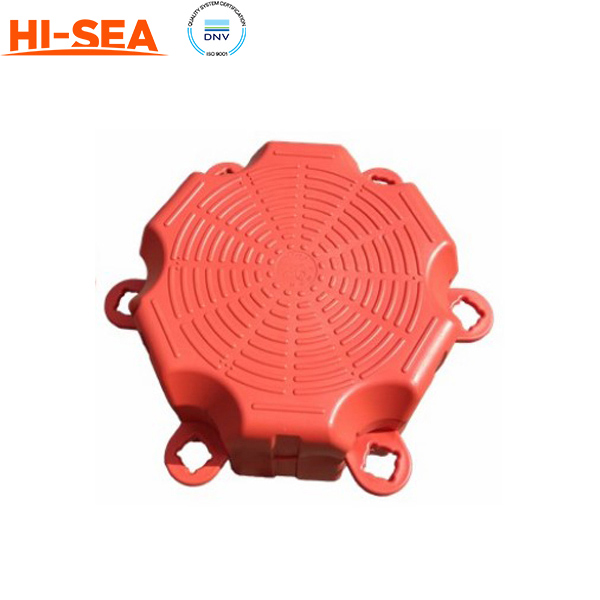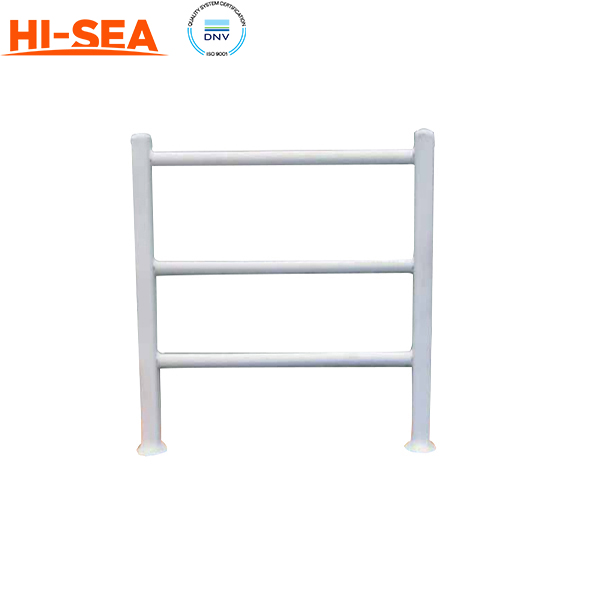MARINE & OFFSHORE EQUIPMENT
- Dredging Equipment
- Marine Deck Machinery
-
Marine Mooring Equipment
-
Marine Anchor
- AC-14 HHP Anchor
- Admiralty Anchor
- Beldt Stockless Anchor
- Bruce Anchor
- Spek Anchor
- Danforth HHP Anchor
- Delta High Holding Power Anchor
- GB11579-89 Light Weight Anchor
- Hall Anchor
- High Holding Power Mastrosov Anchor
- Hot Dip Galvanized Anchor
- Japan Stock Anchor
- JIS Stockless Anchor
- Pool Anchor
- Single Fluke Anchor
- Stainless Steel Anchor
- Stevpris MK5 Anchor
- Stingray Anchor
- US Navy Stockless Anchor
-
Marine Anchor Chain
-
Marine Shackle
- Kenter Shackle
- D Type Joining Shackle
- Pear Shaped Shackle
- Anchor Swivel Shackle Type A
- Anchor Swivel Shackle Type B
- Buoy Shackle Type A
- Buoy Shackle Type B
- C Type Detachable Connecting Link
- D Shackle
- Forelock Shackle
- Anchor Chain Swivel Group
- Straight Shackle
- Anchor Shackle
- Marine Triangle Plate
- Anchor Chain Swivel
- Anchor Chain Joining Shackle
- Anchor Chain End Shackle
- Slim Kenter Shackle
-
Chain Chaser
-
Marine Bollard
-
Marine Chock
-
Marine Fairlead
-
Marine Chain Stopper
-
Marine Mooring Reel
-
Marine Towing Bracket
-
Mooring Rope
-
Marine Towing Hook
-
Marine Shark Jaw
- Marine Fender
-
Marine Buoy
- Marine Floating Pontoon Dock
-
Marine Anchor
- Aquaculture Equipment
- Marine Outfitting Equipment
- Marine Propulsion System
-
Marine Painting
-
Marine Auxiliary Machinery
- Marine Air Compressor
- Marine Air Receiver
- Marine Sewage Treatment Plant
-
Marine Diesel Generator Set
- Marine Oil Water Separator
- Ballast Water Management System
- Marine Hydrophore
- Marine Calorifier
- Seawater Desalination Plant
-
Marine Oil Separator
- Marine Fuel Oil Supply Unit
- Marine Heat Exchanger
-
Marine Hot Well Unit
-
Marine Incinerator
-
Marine Boiler
-
Marine Valve
- JIS Marine Valve
- DIN Marine Valve
- ANSI Marine Valve
- GB Marine Valve
- CB Marine Valve
- CBM Marine Valve
-
Marine Gate Valve
-
Marine Globe Valve
-
Marine Angle Globe Valve
-
Marine SDNR Valve
-
Marine Angle SDNR Valve
-
Marine Check Valve
-
Marine Storm Valve
-
Marine Butterfly Valve
-
Marine Quick Closing Valve
-
Marine Fire Valve
-
Marine Self Closing Valve
- Marine Valve Accessories
-
Marine Pump
- Marine Centrifugal Pump
- Marine Screw Pump
-
Marine Gear Pump
-
Marine Vortex Pump
-
Marine Ejector Pump
-
Marine Diaphragm Pump
-
Marine Piston Pump
-
Marine Fire Pump
-
Marine Emergency Fire Pump
-
Marine External Fire Pump
-
Marine Ballast Water Pump
-
Marine Fuel Pump
-
Marine Lubricating Oil Pump
-
Marine Bilge Pump
-
Marine Sewage Pump
-
Marine Domestic Water Pump
-
Marine General Pump
-
Marine Cargo Oil Pump
-
Marine Hand Pump
- Marine Pump Parts
- Marine Life-saving Equipment
- Fire-fighting Equipment
- Marine Cable
- Marine Electrical Equipment
- Marine HVAC
-
Labour Protection Appliance
- Marine Decorative Material
-
Marine Anode
- Marine Pipe Fitting & Flange
- Marine Instrument
- Ship Building Equipment
INDUSTRY EQUIPMENT
- Hoisting Equipment
- Welding Machine & Material
-
Cutting Machine
- Container Securing Fitting
- Link Chain
- Container & Storage Equipment
-
Diesel Generator Set
- Other Equipment and Tools
- Petrochemical Equipment
- Fiber Reinforced Plastics
- Polymer Materials
- Environmental Protection Series
- Geo-products and Building Materials
- Metal Mesh
- Steel Grating
-
Earthwork Teeth
-
Turnbuckle
STOCK LIST
Contacts
 Tel:+86-23-67956606
Tel:+86-23-67956606
 FAX:+86-23-67956622
FAX:+86-23-67956622
 Email:manager@cqhisea.com
Email:manager@cqhisea.com
Working Time: 9:00--17:00
Working Day: Monday to Friday Website: www.cqhisea.com

HDPE Plastic Floating Pontoon Dock
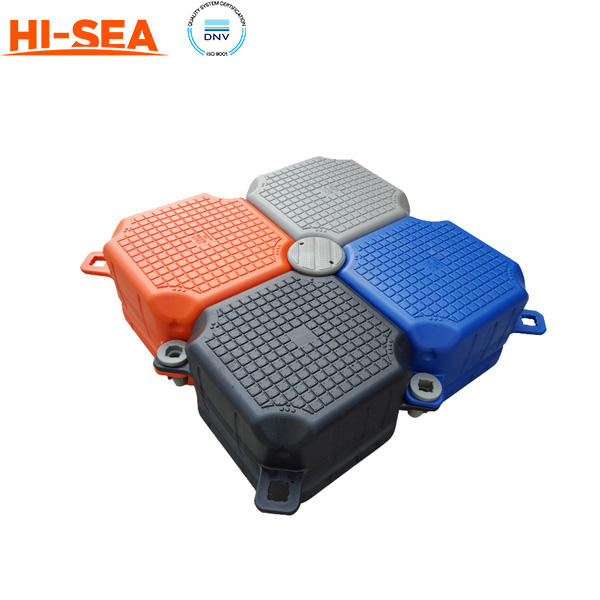
HDPE Plastic Floating Pontoon Dock
Description:
A High-Density Polyethylene (HDPE) plastic floating pontoon dock is a versatile and durable structure designed to provide a stable platform on water bodies. It consists of individual modular units that are interconnected to create a larger dock system. HDPE, a robust thermoplastic material, is used to construct the pontoons due to its excellent buoyancy, resistance to corrosion, and longevity in marine environments.
The floating pontoon dock is typically made up of a series of interlocking modules that form a stable and secure platform. These modules feature a hollow structure, filled with air or foam, which enables them to float on the water's surface. They are designed to distribute weight evenly and provide stability, allowing people to safely walk, lounge, or perform various activities on the dock.
The modular design of HDPE plastic floating pontoons offers flexibility and customization options. It allows for easy assembly and disassembly, making it convenient to transport, install, and reconfigure the dock system as needed. The modules can be linked together using interlocking mechanisms, creating a seamless and stable surface that can accommodate different shapes and sizes.
HDPE plastic floating pontoons are known for their durability and resistance to harsh environmental conditions. They can withstand exposure to UV radiation, extreme temperatures, saltwater, and chemicals, ensuring their longevity and minimal maintenance requirements. Additionally, the smooth surface of HDPE prevents the growth of algae and other marine organisms, reducing the need for regular cleaning and maintenance.
These floating pontoon docks serve a variety of purposes, including recreational, commercial, and industrial applications. They can be used as marina docks, boat moorings, swimming platforms, fishing piers, water sports arenas, and even floating homes or resorts. Their versatility, stability, and low environmental impact make them popular choices for waterfront developments, marinas, and leisure facilities.
Different Types:
HDPE plastic floating pontoon has many types according to its different appearances. Including single pontoon cube, twin connected pontoon, four connected pontoon, v-shaped floating pontoon, U-shaped pontoon, etc.
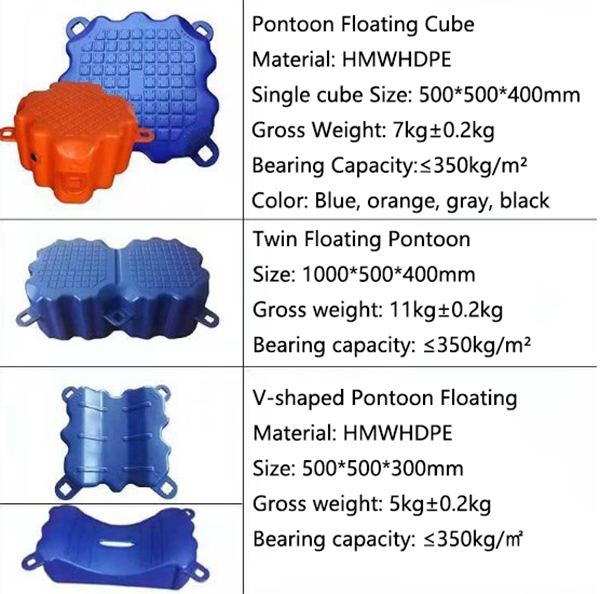
The vertical bearing capacity of the floating dock:
(1) Monomer buoy height of 40 cm, every square meter is composed of four buoy, 100% load of 350 kg 1 per square metre.
(2)No-load draft depth of about 2.5 ~ 3cm;
(3) Carry 230 kg (about 15 ~ 20 cm deep drawing (safety);
(4)When carrying 350 kg at depths of about 35 ~ 40 cm (load limit).
(5)Double buoy height is 80 cm, every square meter is composed of eight buoy, 100% load of 640 kg 1 per square metre.
(6)No load draft depth of about 3 ~ 5 cm;
(7)Carry 460 kg of deep drawing about 40 ~ 50 cm (safe use);
(8)When carrying 700 kg at depths of about 70 ~ 80 cm (load limit).
Anchorage method of floating wharf:
1. When the water depth is less than 3 meters, steel piles should be fixed at appropriate positions and connected with roller sliding frame to prevent the floating wharf from moving horizontally from left to right and automatically rise and fall with the water level.
2. Water depth is more than 3 m, recommend sink anchor fixed bottom, steel cable cross traction mode of anchorage.
Note:
1. Temperature: from -60°C to ≤80°C is the normal working environment of our platform.
2. Strong corrosion resistance, UV protection, antifreeze, resistance to seawater, the erosion of chemical agent, oily be soiled, etc.
3. Water waves within 2-3 for safe use scope.
4. Surface waves can be used within 3-5, but it must be to strengthen security protection, prevent tourists slipped
5. Surface waves within 5-8 to limit usage. (ships berthing and tourist boats up and down is not recommended)


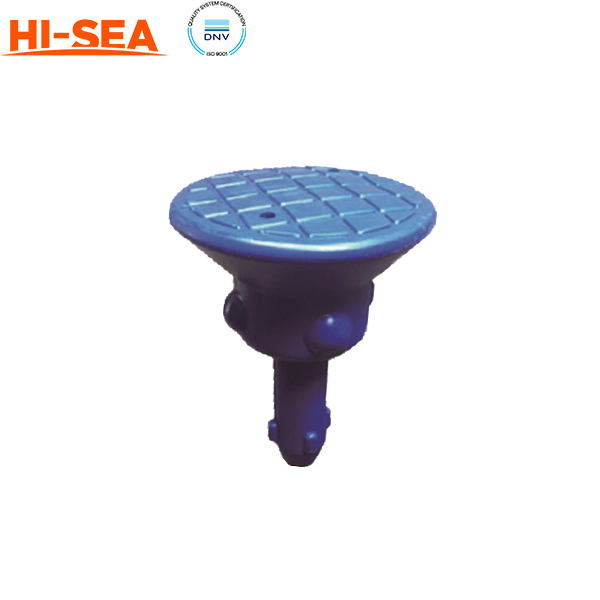
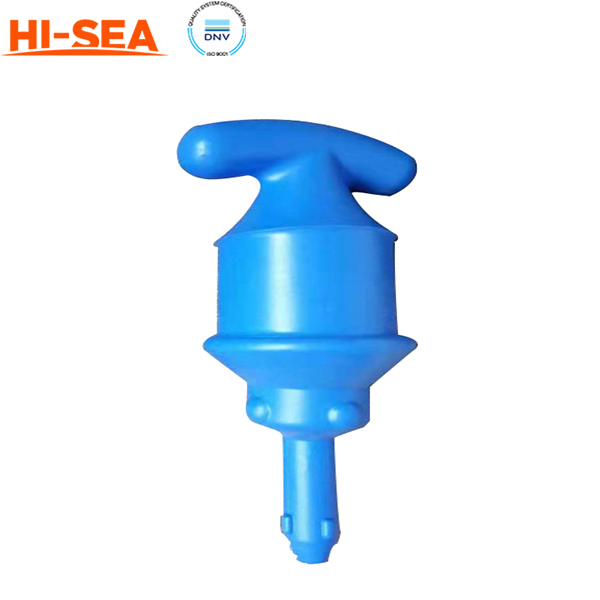
.jpg)
